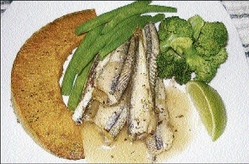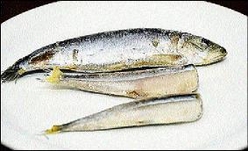All about cooking with fresh sardines
Published: Thursday | September 24, 2009

Fresh grilled sardines served with a white wine sauce, blanched string beans and broccoli, and baked pumpkin. - Barbara Ellington/Lifestyle Editor
Sardines are sustainable, delicious and good for you. Sardines - I'm talking the fresh kind, not canned — are one of nature's great gifts. They are plentiful on both coasts, inexpensive, loaded with the omega-3 fatty acids health officials are crowing about, and they are absolutely delicious.
Sardines are a small schooling fish that roam the open oceans eating plankton and small crustaceans. They are, in turn, eaten by, well, just about everything, including people.
You are probably most familiar with canned sardines, and they are an excellent product when well made. I eat canned sardines mostly in winter, and fresh ones in warm weather.
Finding fresh sardines is a good reason to drop everything and call all your friends. Sardines rot faster than almost any other fish - it's all those omega-3s - so eat them the day you buy them.
Another reason for urgency is that sardines do not freeze well. The oils in them turn rancid even in a freezer and the flesh becomes a mushy mess when thawed. My advice: never freeze fresh sardines.
Look for sardines that are clean-smelling and whole. Try to avoid bruised fish and definitely avoid any fish with 'belly burn', a condition where the belly is broken and the guts are starting to come out. This is a sign of an old fish, suitable only for salting down.
What do you do with them? Why, grill them, of course. Wrapped in grape or fig leaves, grilled over charcoal with olive oil and lemon, fresh sardines outshine pretty much any other seafood in my book.
But you do have to deal with the bones. The best way to do this is to split or butterfly your sardines. Do this and you will only have a few gossamer bones remaining, and they are soft enough to eat safely.
You can also fillet fresh sardines and marinate them in salt, olive oil and lemon juice to make a Mediterranean version of ceviche. This is a common way to serve sardines in Greece, Spain and Italy.
Fresh sardines are also good filleted and baked. They go well with full-flavoured sauces, especially tomato sauces. Spicy, citrusy salsas also work well.
But the bottomline is this: If you find truly fresh sardines, simplicity is the key. Enjoy the rich flavour of the fish with little more than salt, lemon and a little olive oil.

Headless sardines, scaled, deboned and gutted (in front) and a whole one with head and gut. Jamaicans are used to the canned variety but National Meats, located in Lydford, St Ann, will make fresh sardines available to Jamaicans within the next two months. - Ian Allen/Photographer
Baked Fresh Sardines
Ingredients
900g (2lb) sardines, cleaned and trimmed
fat for greasing
45ml/3 tbs olive oil
2 large onions, finely chopped
45ml/3 tbs medium-dry white wine
225g (8 oz) tomatoes, peeled, seeded and chopped
salt and pepper
3/4 cup (50g) fresh white breadcrumbs
2tbs (1oz) 25g butter
Watercress (salad cress) sprigs to garnish
Method
1. Grease a shallow oven-proof baking dish. Set the oven at 180C/350F
2. Heat the oil in a small saucepan, add the onions and fry gently for about five minutes until lightly browned.
3. Add the wine and boil until the volume is reduced by two-thirds. Stir in the tomatoes, with salt and pepper to taste. Cook for 3-4 minutes.
4. Pour the tomato mixture into the prepared dish, arrange the sardines on top and sprinkle with the breadcrumbs. Dot with the butter and bake for 25 minutes.
Grilled Fresh Sardines
Ingredients
900kg/2 lb very heavy fresh sardine, gutted and with heads removed
olive oil, for brushing
salt and ground black pepper
45ml 1/3 tbs chopped fresh parsley, to serve
lemon wedges, to garnish
Serves 4-6
Method
1. Preheat the grill. Rinse the sardines in water. Pat dry with kitchen paper.
2. Brush the sardines lightly with olive oil and sprinkle generously with salt and pepper. Place the sardines in one layer in a grill pan. Grill for about 3-4 minutes.
3. Turn and cook for 3-4 minutes more, or until the skin begins to brown. Serve immediately, sprinkled with parsley and garnished with lemon wedges.
Note: Frozen sardines will be available in Jamaica in another two months because National Meats will be importing them. They can keep well in the freezer for six weeks. Thaw them in the fridge overnight, then use a sharp pointed knife to slit the belly, remove the innards and cut the heads off. For a further flavour, you might like to leave them whole, as they do in some Mediterranean countries.
